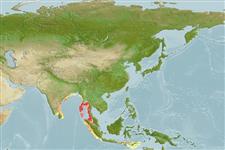>
Acanthuriformes (Surgeonfishes) >
Lobotidae (Tripletails)
Etymology: Hapalogenys: Greek, hapalos = soft * Greek, geny, -yos = face (Ref. 45335); merguiensis: Named for its type locality, Mergui Basin, southern Myanmar Sea..
Environment: milieu / climate zone / depth range / distribution range
Écologie
marin; profondeur 78 - 180 m (Ref. 36944). Tropical
Eastern Indian Ocean: known only from the Andaman Sea, off southern Myanmar, including Mergui Basin and Taninthayi Coast, and off Phuket, west coast of Thailand. Possibly occurring in the Andaman and Nicobar islands, Bay of Bengal and Straits of Malacca.
Taille / Poids / Âge
Maturity: Lm ? range ? - ? cm
Max length : 17.9 cm SL mâle / non sexé; (Ref. 36944); 24.2 cm SL (female)
Description synthétique
Morphologie | Morphométrie
Épines dorsales (Total): 6; Rayons mous dorsaux (Total): 14; Épines anales 3; Rayons mous anaux: 9 - 10; Vertèbres: 24. Head and body generally dark brownish when fresh. Two indistinct oblique dark bands on body, the first descending from the nape to behind the pectoral fin; the second from base of anterior 2nd or 3rd dorsal fin spines and soft dorsal fin base, curving backward thru the lateral line to soft anal fin and caudal peduncle. Maxillary scales absent. Eye diameter greater than one quarter of the head length. Ten pores on and behind the chin; often with slitlike pores posteriorly. Fleshy lower lip with a cluster of very short dense papillae. At the origin of the dorsal fin is a procumbent spinelike process (exposed tip of first pterygiophore) (Ref. 36944).
Occurs over rocky bottom.
Life cycle and mating behavior
Maturité | Reproduction | Frai | Œufs | Fécondité | Larves
Iwatsuki, Y., U. Satapoomin and K. Amaoka, 2000. New species: Hapalogenys merguiensis (Teleostei; Perciformes) from Andaman Sea. Copeia 2000(1):129-139. (Ref. 36944)
Statut dans la liste rouge de l'IUCN (Ref. 130435)
Utilisations par l'homme
Plus d'informations
Noms communsSynonymesMétabolismePrédateursÉcotoxicologieReproductionMaturitéFraiRassemblement de ponteFéconditéŒufsDéveloppement de l'œuf
Taille/ÂgeCroissanceLongueur-poidsLongueur-longueurFréquences de longueursMorphométrieMorphologieLarvesDynamique des populations larvairesRecrutementAbondanceBRUVS
RéférencesAquacultureProfil d'aquacultureSouchesGénétiqueElectrophoresesHéritabilitéPathologiesTraitementNutrientsMass conversion
CollaborateursImagesStamps, Coins Misc.SonsCiguateraVitesseType de nageSurface branchialeOtolithesCerveauxVision
Outils
Articles particuliers
Télécharger en XML
Sources Internet
Estimates based on models
Preferred temperature (Ref.
123201): 17.6 - 23.2, mean 21.7 °C (based on 14 cells).
Phylogenetic diversity index (Ref.
82804): PD
50 = 0.5078 [Uniqueness, from 0.5 = low to 2.0 = high].
Bayesian length-weight: a=0.01862 (0.00830 - 0.04177), b=3.01 (2.81 - 3.21), in cm total length, based on LWR estimates for this (Sub)family-body shape (Ref.
93245).
Niveau trophique (Ref.
69278): 3.9 ±0.6 se; based on size and trophs of closest relatives
Résilience (Ref.
120179): Haut, temps minimum de doublement de population inférieur à 15 mois (Preliminary K or Fecundity.).
Fishing Vulnerability (Ref.
59153): Low vulnerability (20 of 100).
